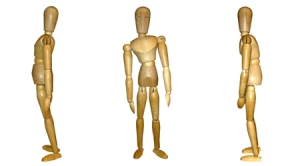‘Poor’ posture is the result of habituated dysfunctional patterns of involuntary contraction aka Sensory Motor Amnesia (SMA). Or, put more simply, excessive levels of involuntary muscular tension in one place or another that pull us out of shape and cause muscular imbalances. In fact, the Three Reflexes, Green Light, Red Light an Trauma, show up in our bodies as postural distortions.

Poor posture as a result of habituated Green Light Reflex, Trauma Reflex and Red Light Reflex. Most people will have all three to some degree.
Excessive time spent sitting/driving/doing desk work can lead to SMA in relation to the muscles of the front of the body (Red Light Reflex). You lose the ability to lengthen these muscles to their true resting length. When these muscles are tight they round the shoulders forward, pull the chest, and in turn the head, down and forward into typical slumped posture.
Often, in a situation as illustrated above, the conventional view is that the muscles of the back of the body are ‘long and weak’ and the muscles of the front are ‘tight and short’. I would argue the tight side is not weak, it is perfectly strong, it is also fatigued. If you touch a tight muscle you will feel how it is very hard, that is because it is strongly contracted. The perceived ‘weakness’ is a result of the fatigue from being constantly contracted and constantly using energy. There is a difference between being weak and being fatigued. The strength of a muscle is dependant on its ability to contract fully and equally to relax fully. A muscle that never relaxes is always tired and so cannot do its job properly.
What about the muscles on the other side that are thought to be ‘long and weak’? The muscles on the opposing side, are longer yes, but again they are not weaker. They cannot contract fully because the opposing muscles are ‘stuck’ in contraction (SMA) as described above. Muscles always work in opposing pairs/groups. If the function of one pair/group is compromised it automatically compromises the function of the opposing pair/group. This is a clear example of Reciprocal Inhibition*. Proper co-ordination between the two muscle groups must be restored.
This distinction is very important. When we restore the ability to fully relax the ‘tight/short’ side (by eliminating the SMA through pandiculation), the ‘longer/weaker’ side is no longer inhibited and so it can contract fully again. This restores co-ordination and balance between the muscles. With this improved balance and co-ordination improved movement, comfort and posture is inevitable.
Good posture, relaxed and tall, is the absence of excessive muscular tension throughout the body and balance and co-ordination between opposing muscle groups. With good posture you will be able to move quickly if you need to, without excess muscle tension. It’s not about tightening muscles in order to stay standing upright.
Improved posture can be attained quickly and easily through Somatic Movements. They allow you to eliminate SMA and so remain in a fair state of relaxed balance. Poor posture cannot be ‘fixed’ by adding MORE tension to muscles that are incorrectly thought to be WEAK!
In Summary:
Poor Posture = unnecessary involuntary tension in the body causing imbalance.
Good posture = the absence of unnecessary involuntary tension in the body.
Think about it…
If you would like to learn how to eliminate SMA and improve your posture using simple Somatic Movements you can start right now over at Learn Somatics on YouTube. If you need some help check out my online learning options here.
As always, thanks for reading.
*Reciprocal Inhibition: contraction in a muscle is accompanied by a loss of tone or by relaxation in the antagonistic muscle.
Photo by Valentin Salja on Unsplash
